When I was a little girl I was very close with my grandparents. On treasured weekends I would spend at their house, my grandmother would allow me to do most anything. This usually involved indulging in real cream and real butter and homemade fudge. For some odd reason I loved mopping her pink linoleum bathroom floor. And what grandmother wouldn’t like that? I would go outside and get my shoes all muddy, only to walk in purposefully and dirty the floor. I would set about cleaning, using one of those silly, thin 1970’s metal squeeze sponge mops. I would do this again and again. Surely this past time is seen as funny to a few of you and I, myself, no longer see the appeal of this type of domestic folly but back then, oh my… it was captivating.
Another thing I loved about weekends at my grandparent’s were trips to their little, neighborhood, corner, grocery store. It was half a block away. It was a true Mom and Pop operation. A small, flat roofed stucco building, nothing to look at, but packed to the gills with anything a neighboring family home could want. Mom and Pop lived in the two-story home attached in the back. For some reason I remember the glass jars of marshmallow crème on an endcap near the cash register. That old patterned linoleum floor was dulled and so soft with use, those tiles long ago exposed to leaky refrigeration accidents, leaving them buckled with character. You may have guessed that I wanted to mop those sad tiles. The air was stale despite the oscillating fan on a back counter and the packed shelves were low, allowing me to see the busy shopping heads and shoulders in other aisles. It smelled like spices and mustiness. Exotic, in my mind. I thought it was all very peculiar and quite unlike the large Safeway in Benson I went to with my parents. It was like going back in time and I knew it.
When I was old enough, my grandmother would send me to that corner store alone. She would customarily call down to the grocer and tell Mom or Pop So&So what she needed for that night’s meal. My grandmother’s usual practice, long annoying to other members of the family, was to shop for groceries daily. By the time I had kicked some rocks down the street and found enough faces in the clouds to last a half a block’s walk, the grocers would have everything bagged up and ready. I remember the shop keep would quickly flip through a worn wooden box only to retrieve an index card with our family surname on it. He would write the total of the bill on the card and have me sign it. I felt so grown up! This was called putting the groceries on our credit or on our bill. I would later learn the grocer would then bill my grandparents, like all of the other neighbors, once a month; a system of payment built on trust.
This was the way that most small shops operated across Omaha previous to the 1950’s. Of course chains had come in long before that, but it was still common in these parts to have an independent corner shop business into the 1970’s. I was lucky to have even experienced it. Small, independent stores run by a real family were often found in neighborhoods where it was convenient to walk to or on the streetcar line. These little shops often offered delivery, a line of credit, layaway and other special offerings, dependent on the type of business. They did not have much buying power, which didn’t really matter because most of the shops had comparable prices because of a level playing field. They had low inventory, just buying what they needed. For this reason there was low overhead with less expensive rent. Most importantly every little shop was dealing with a small number of customers in their very area, well known and often treated like family. People knew one another and there was close-knit, community exchange during these interactions. It was good for business for a shop owner to familiarize himself with his patrons. Your butcher knew what cut you liked. Your baker knew what rolls you liked for your dinner party. Your grocer knew exactly what you preferred and might call you personally when he got in a special item. Your tailor knew the way you wanted your suit to fit. On and on. A vibrant, local retail economy. In this time there was room for many different little grocers, dry cleaners, tailors, gas stations to get in the game, all operating on their little corner. Diversity and quality were valued, not only with regard to distinct inventory and the varied, sometimes big personalities of the shop owners but the historic storefront buildings sprinkled about town, the novel interiors and the differing hand painted signs of these businesses. Diversification. We very rarely see anything like this in this day and age. These Mom and Pops were not yet competing with the big national or local chains. Big Box retail was inconceivable.
These small businesses, all of the hard working families that created them and of course, the structures that housed them are what my next series is about. My first case will be focusing on 3812 Farnam Street, one of my all-time favorite places, owned by two of my very favorite people, Brothers Lounge. When I began tracking this case, I had no idea of the long, proud lineage of Mom and Pop Shops to have hung their rightful shingle at 3812 Farnam.

Photograph of 3812 Farnam borrowed from the Douglas County Assessor site.
Part One
Lay of the Land
I first began gathering clues by looking into the history of Farnam Street. According to Streets of Omaha-Their Origins and Changes, Farnam Street was originally spelled Farnham. Pretty odd considering it was named after Henry Farnam, a banker in Hartford, Connecticut. Farnam was famous for promoting the Rock Island Railroad. Farnam Street, in its early days, was well regarded at the original main street of Omaha. As the city grew, waves of the Nouveau Riche began moving their families west (history repeats) into an up and coming area called West Farnam. From the 1997’s “National Register of Historic Places Registration Form of the Gold Coast Historic District,” I traced the origins of West Farnam. The West Farnam District, also called the Gold Coast District, covered 36th to 40th Streets, Jones to Burt Streets. Farnam Street developed, much as it is today, as the commercial center of this neighborhood. As the incredible book, West Farnam Story makes clear, “the name West Farnam denotes a district, not the street.” West Farnam and the Gold Coast District appear to have been used interchangeably. Between 1885 and 1920 West Farnam developed into one of the most opulent parts of town, although noted at the time for being built with “new” money. Perhaps thought too-palatial or vulgar displays of wealth to a discriminating few at the time, the glorious homes of North 38th Street and the Gold Coast are among the most glorious in all of Omaha. West Farnam-Gold Coast’s new money was being made hand over fist by Omaha’s newest crop of entrepreneurs, the rising stars of industry, in time becoming Old Money Omaha, of course. The area was annexed into Omaha by 1897.
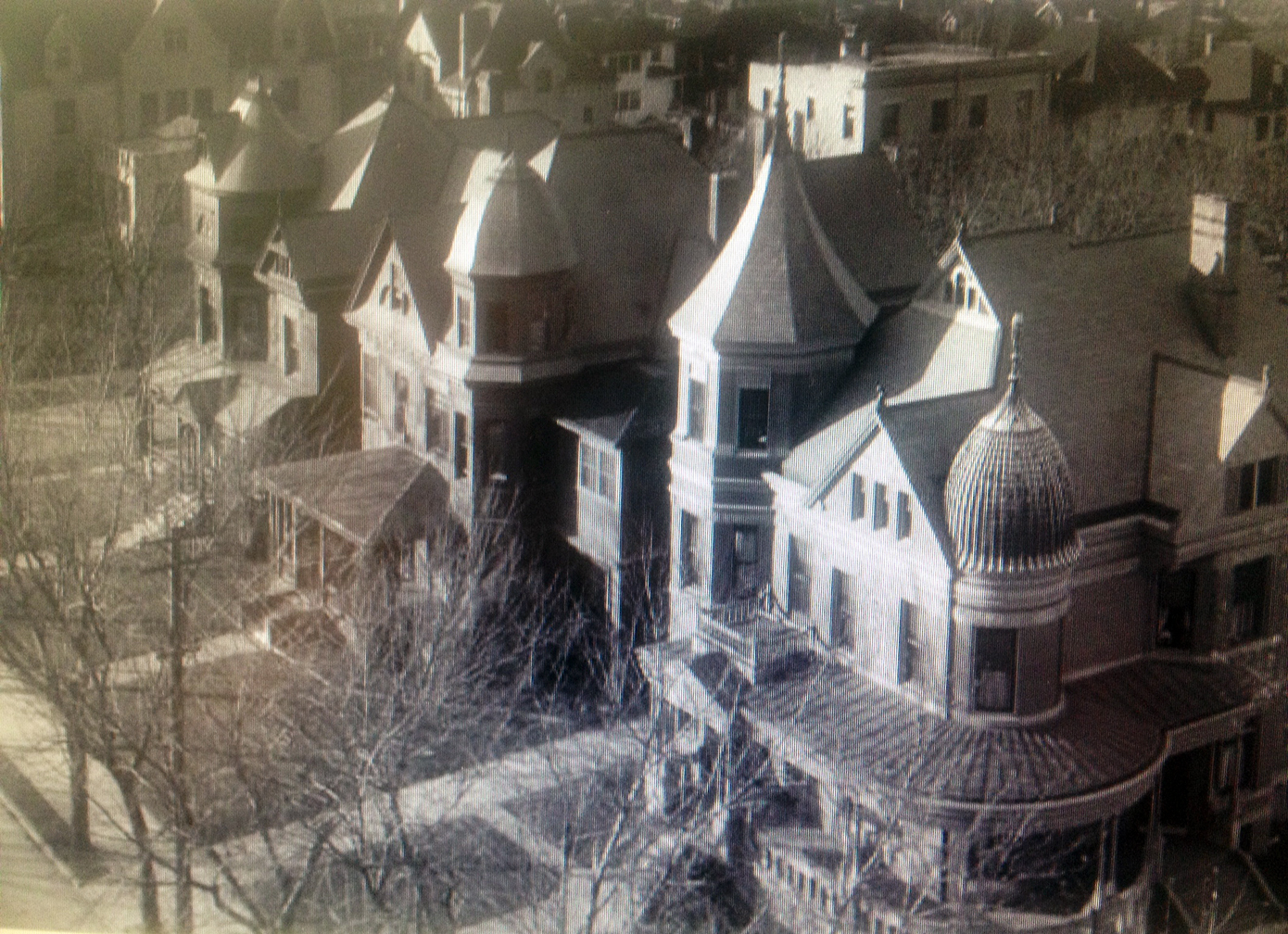 1915 aerial view of a few of the Gold Coast homes, east of the Storz Mansion on Farnam Street. These have been demolished.
1915 aerial view of a few of the Gold Coast homes, east of the Storz Mansion on Farnam Street. These have been demolished.
There were many more original mansions built between 36th and 40th on Farnam that were demolished and replaced with commercial buildings, within this period of historic significance, designated by National Register as 1889-1946. The Storz Mansion at 3708 Farnam is the only existing mansion from the original strip on Farnam. (For a fantastic read on these mansions and their families from this time period, check out West Farnam Story by B.F. Sylvester.) There was a brief period in our Omaha history when several of the mansions were reimagined into funeral parlors, a well-suited use for these lavish homes very few could afford after the 1920’s. (I plan to write a future article about these very Farnam funeral homes but until then, check out Mysteries of Omaha: 3825 South 25th Street.) Others too were converted into apartment homes, rooming houses and a fraternity. Although not original to when the street was developed, a number of the extant commercial buildings on Farnam are considered “contributing,” as indicated by the National Register. These buildings are noted for their integrity, historic association and upholding architectural qualities of this time period, again–1889-1946. From the Reconnaissance Survey of Neighborhoods in Central Omaha, of 2003, I began to piece together the West Farnam-Gold Coast District started to lose some of its shimmer during the 1920’s. Homes continued to be constructed but were smaller and less grand than those built before World War I. For more on this great part of town check out my previous stories Best Little Shops in Omaha: Almost Music-Solid Jackson Bookstore and Then & Now: 40th and Farnam.

Map of the current area surrounding 38th and Farnam.
The Architect Lead
3812 Farnam, I discovered, was, in fact, one of those commercial buildings that was erected after a larger home had been torn down. Just one building west of the corner of 38th and Farnam, 3812 Farnam was constructed as a two bay commercial building in 1926. I am always a bit skeptical of the Douglas County Assessor’s build date, so I reached out to Trina Westman of Urban Design and Historic Preservation at Omaha Planning. She did not have a photo from that 2003 survey but she shared essential additional information from the city’s records of the Reconnaissance Survey. 3812 Farnam was indeed built in 1926. Its architect was H. W. Rathsack.
Herbert W. Rathsack, an Omaha architect, was son of W. A. Rathsack, President of the Security State Bank of South Omaha. The younger Rathsack later was appointed a government construction engineer by the office of the supervising architect in Washington DC. In the early 1930’s he was assigned headquarters in Pittsfield, Mass where H. W. Rathsack would go on to design post offices and other government buildings throughout the East Coast.
The Rathsack tipoff was an early feather in the cap. The second bit of evidence was that 3412 Farnam is formally recognized as being of historical value to Omaha and listed within the “National Register of Historic Places Registration Form of the Gold Coast Historic District.” Originally it carried the addresses 3810 and 3812 and had two separate doors leading to identical rental spaces. The outside of the dark brick building has not changed save for the shingled awnings over the large front windows. Initially the building would have had a traditional, flat storefront. The original flat wooden panels covered by the shake overhang, now painted beige, were surely used for signage by the previous businesses.

Douglas County Assessor floor plan of Brothers Lounge.
Early Farnam Street Clues
 Current frontside view of neighboring buildings. There is quite a bit of construction going on around here lately, if you haven’t been by in a while.
Current frontside view of neighboring buildings. There is quite a bit of construction going on around here lately, if you haven’t been by in a while.


It is important to note the buildings surrounding 3812 Farnam for contextual relation. These sister buildings were erected at varying stages of the West Farnam business district. The Colonial Hotel at 3804 Farnam, also known by the address 144 S 38th Street, was built in 1907, according to the Douglas County assessor. Other accounts say the Colonial was built in 1910. This discrepancy may be accounted for by the addition to the Colonial, giving the impression of two separate buildings. There are two front doors, one facing 38th, the other, more proper front door, faces Farnam. The Blackstone Hotel, just east on Farnam was not built until 1912. The Colonial is historically significant to this area as an example of an “apartment hotel,” where a residential building could be used for either monthly living or upper scale hotel accommodations. This is rarely seen any more. The Colonial had upheld that model until just this April of 2016 when the hotel was sold to GSCD 3804 LLC aka developers GreenSlate and Clarity.

Check out the OWH article for more details. http://www.omaha.com/money/m-conversion-to-upscale-apartments-hopes-to-restore-colonial-hotel/article_1c972d1e-7d33-5e08-8ba6-c20388bd173a.html
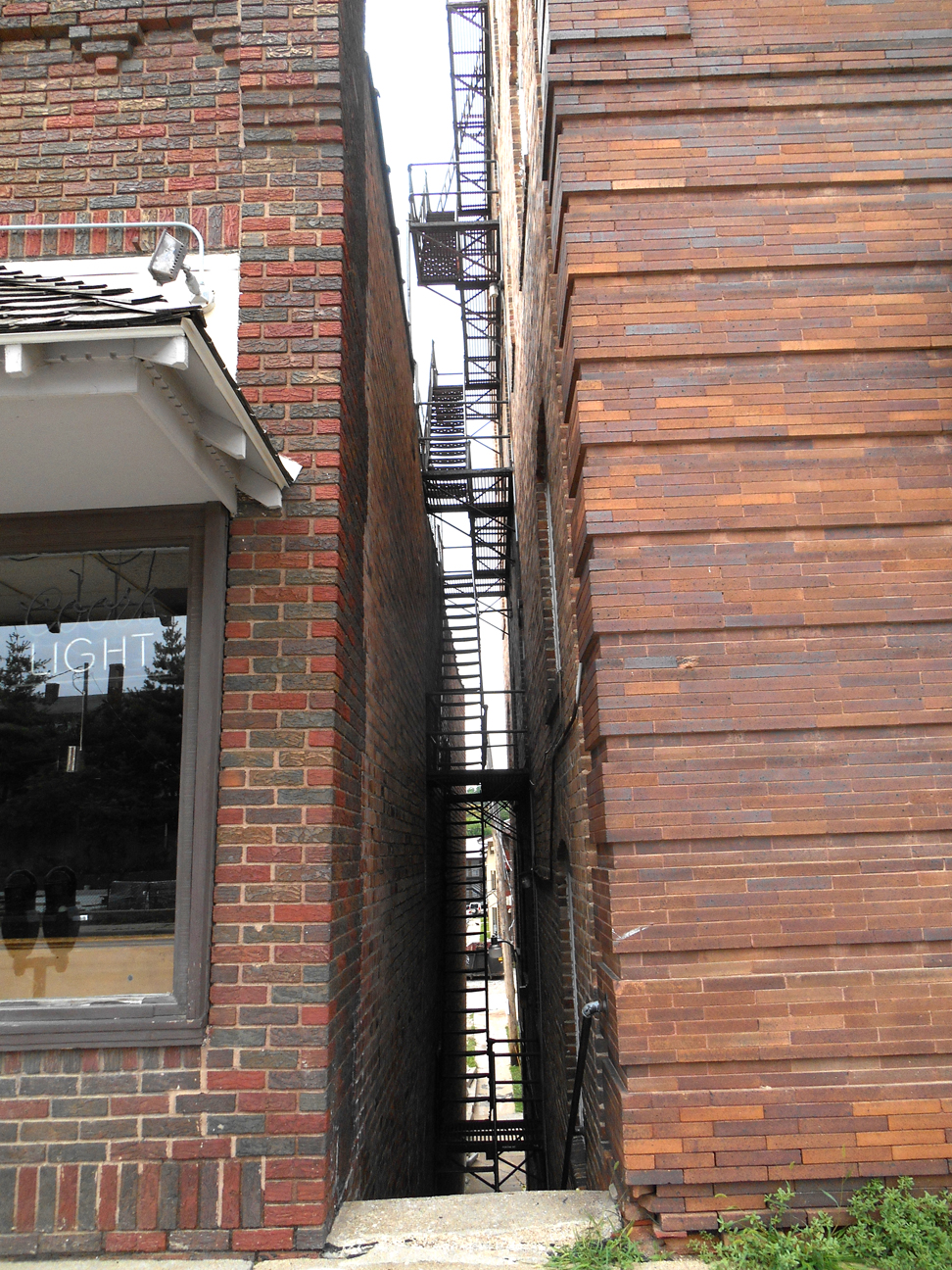
Has anyone else been on the roof of the Colonial Hotel? Just wondering….

I just love this ol’ girl. The Colonial Hotel. Advertisements found from the mid 1920’s describe the Colonial as “A delightful place to live—1, 2, 3 room suites available. Breakfast and evening dinners.”

3814 Farnam, directly west of 3812, (which has had a Central Distribution sign hanging from it for as long as I can remember), was constructed in 1916. It is interesting to note how very close in proximity all three of the businesses are, as if they were built at the same time. As I say, sister buildings.

Rear view of the Colonial Hotel.

Easement behind 3814 Farnam currently being used for the Colonial Hotel renovation.

Where Central Distribution Co. meets Brothers Lounge.
 The three original businesses with the addition of new Blackstone apartment building to the west.
The three original businesses with the addition of new Blackstone apartment building to the west.
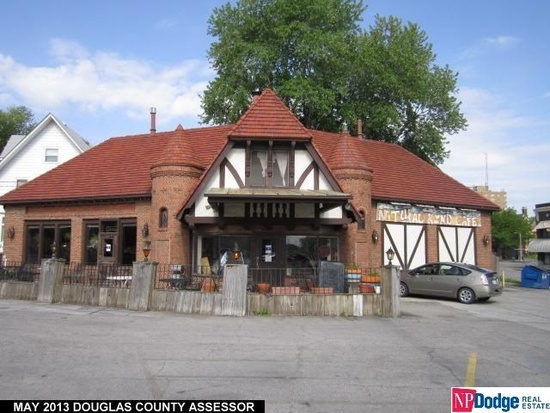
Johnny-come-latelies to the block, 302 S. 38th Street, originally the White Rose Service Station, was built in 1930. In more recent decades this was McFoster’s Natural Kind Café. One of my favorite midtown buildings.
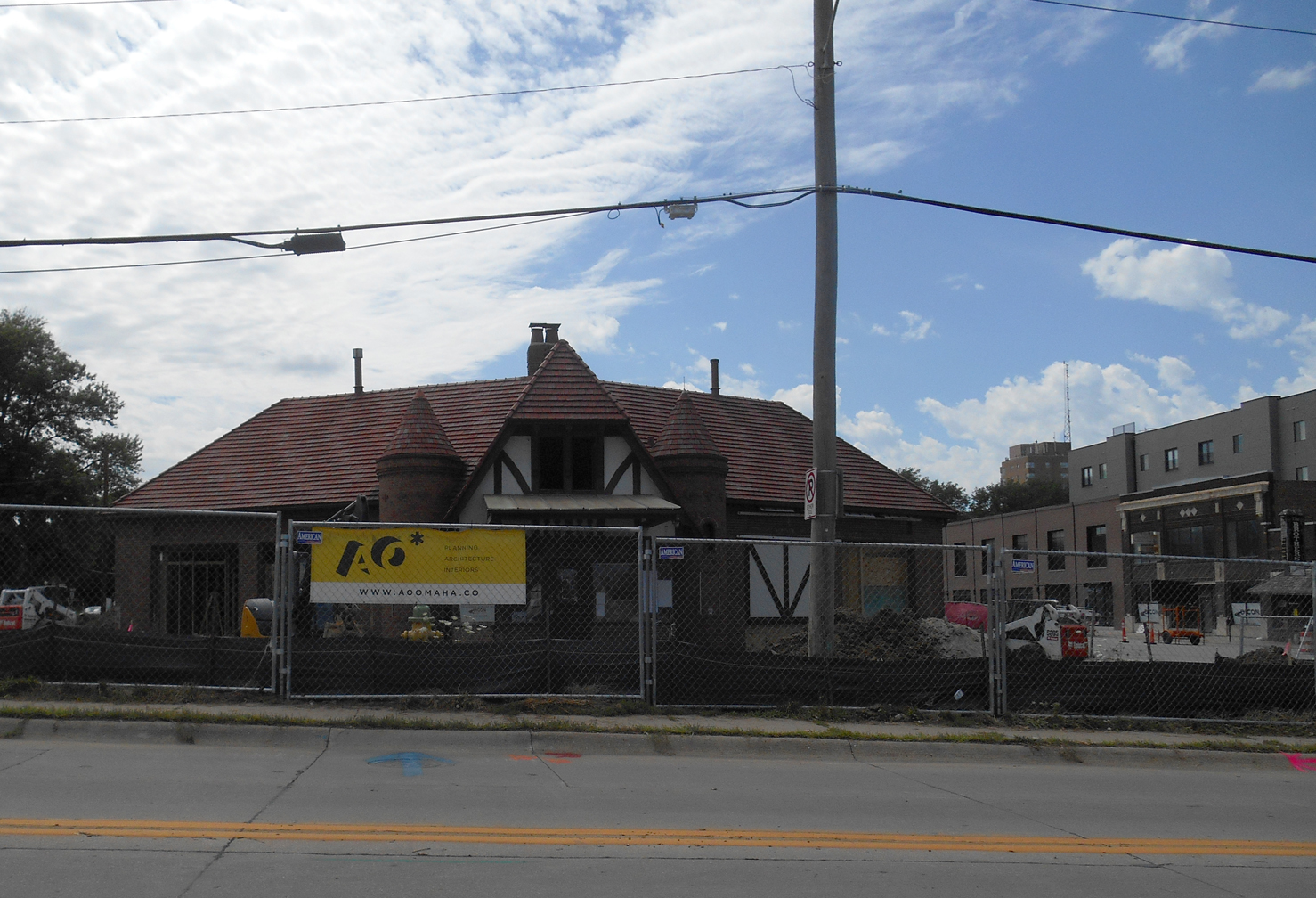 McFoster’s Natural Kind Café, 302 S 38th Street, currently being remodeled in the Dundee Bank. To the right you can see the additional construction going on in the background.
McFoster’s Natural Kind Café, 302 S 38th Street, currently being remodeled in the Dundee Bank. To the right you can see the additional construction going on in the background.
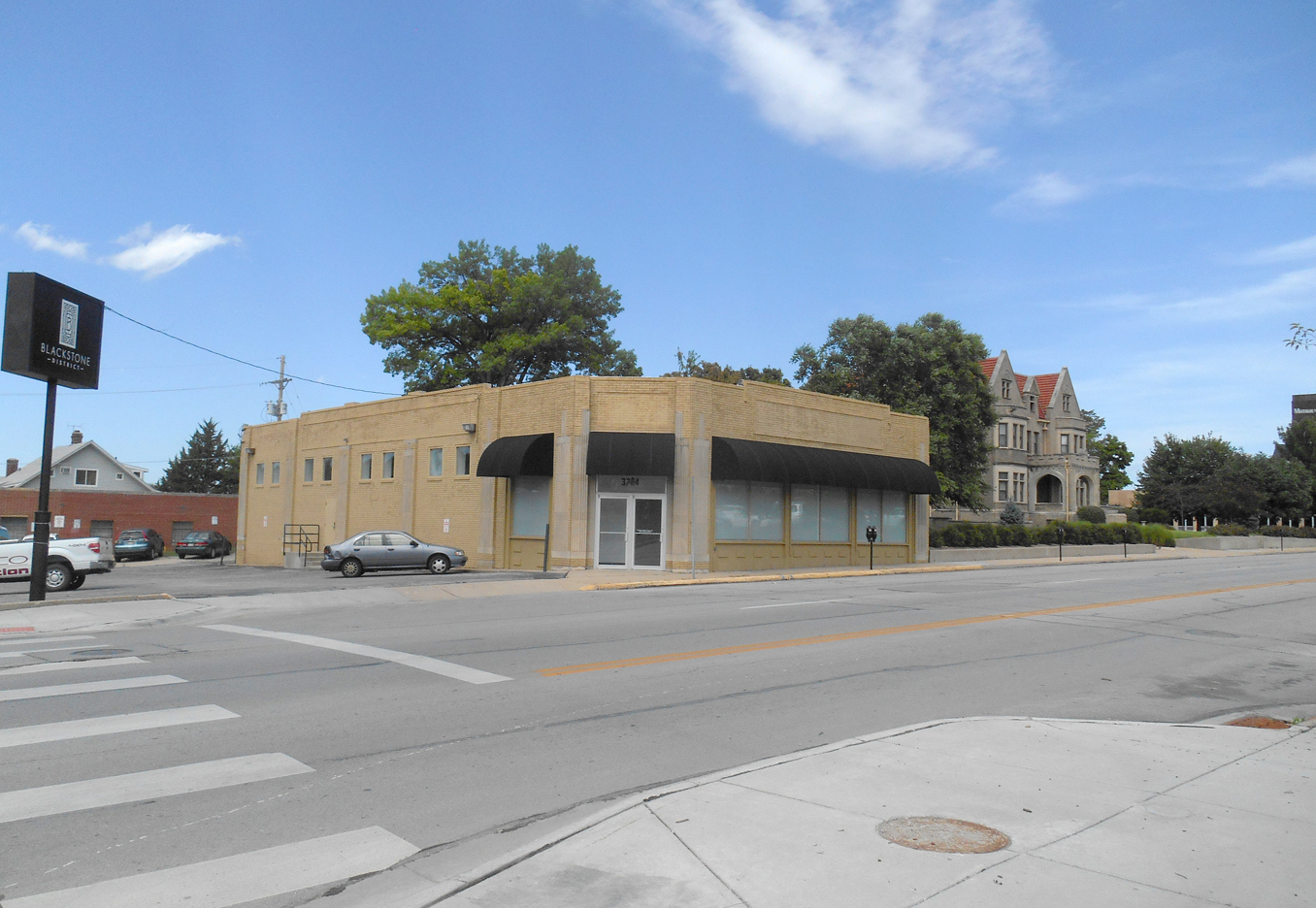 3724 Farnam, now the Hi-Fi House, most recently Joseph’s College of Barbering, was built in 1934. As I’ve mentioned before, addresses change over times. 3724 was previously 3720 and before that it was a mansion with the address of 3718 Farnam. But I will get into more of that later. The ever glorious Arthur Storz Mansion is seen to the east of the building.
3724 Farnam, now the Hi-Fi House, most recently Joseph’s College of Barbering, was built in 1934. As I’ve mentioned before, addresses change over times. 3724 was previously 3720 and before that it was a mansion with the address of 3718 Farnam. But I will get into more of that later. The ever glorious Arthur Storz Mansion is seen to the east of the building.
Mom and Pop Grocers
By 1916 the Colonial Hotel was owned and managed by Mrs. Sarah Cook. She would be one of a number of solo female proprietors I found who ran the Colonial, which I love to imagine. Farnam must have been such a very different street then. With substantial mansions, like a Sunday promenade up and down the block, 3804 (the Colonial Hotel) and 3814 (originally the Blackstone Garage), were the only businesses on that corner from 1916 through 1926. The Blackstone Garage was also on 36th and Farnam, a few doors to the east of the Blackstone Hotel in 1919. I would find out later, after happening upon a lovely photo of yet another Blackstone Garage at 19th and Douglas from 1919, (thanks to the help of Joe Knapp, GIS mapping professional with the City of Omaha, Planning Department) that this garage must have been a local franchise. I cannot be sure if the 3814 location was its third business or an additional storage garage.
As I had previously indicated, 3810 and 3812 were built in 1926. Unfortunately there was no business listed at these addresses in the 1926 city directory and the 1927 directory happens to be permanently missing from the library. Drats! However, I was lucky enough to find an advertisement from the Omaha World Herald, dated April 25, 1927. This ad stated “A-1 Cook Wanted. References Required. 3812 Farnam.” One might assume 3812 Farnam began life as a restaurant but these facts are obscured. I cannot say for certain that this little restaurant to be even got off the ground or if it was just some Joe Lunchbucket’s pipedream.
In 1928 the 3810 Farnam bay fell vacant meanwhile a new inhabitant moved into 3812. The Farnam Market, a mom and pop grocery owned by Jacob Cohen, was undoubtedly a warmly welcomed business on this mostly residential street. Try as I might, I could not find anything on Jacob Cohen or his Farnam Market in the outstanding book, Memories of the Jewish Midwest Mom and Pop Grocery Stores, Volume 14, available through the Nebraska Jewish Historical Society. Through the NJHS burial registry, I did find date of death listings for two Jacob Cohens, in 1956 and 1976 but I cannot speculate as to which one, if either, is our little mom and pop grocery owner. I was able to find one ad in the OWH.
 January 13, 1928 J. Cohen Grocery Store. Constantly endeavoring!
January 13, 1928 J. Cohen Grocery Store. Constantly endeavoring!
By May 30, 1928, it would appear that Jacob Cohen was leaving town. The OWH ad read, “Grocery for sale, sacrifice price, sales over $2,000 a month. Neatest store in Omaha. Leaving city. Low rent. Farnam Market. 3812 Farnam St. Omaha.”1929 brought the Shafer Brothers Tailors and Cleaners to the 3810 bay— coincidentally, the first brothers at this address to bootstrap their way to success. I. Shafer of the Shafer Brothers would later become a member of the Omaha Chamber of Commerce in 1933. ***UPDATE***I recently heard from a fabulous read who believed that I. Shafer might have been her grandfather, Isadore Shafer. She also suggested that Aaron, might have been the “brother” in the business. I did some further detective work and discovered that she was correct. Additionally I found some great articles about her grandfather. “Isadore Shafer, tailor of 3810 Farnam, found two $50 bills in a man’s trousers watchpocket, that had been dropped off to be tailored.” Mr. Shafer found the man, William Barnaby of St. Louis and returned the money. I enjoy that this bit of good news, was newsworthy in those days. In 1945 Mr. Shafer went on to become a designer and production manager of a clothing company that originally made uniforms for the war effort and later created women’s fashions.
More surprising to me, in 1929, 3812 Farnam Street became a neighborhood Hinky Dinky Grocery. Although mostly small, corner grocery shops, Hinky Dinky was a local phenomena. By 1932 the local chain had amassed 26 locations. They would grow to 70 venues throughout their history. 3812 Farnam was just one of them. In the early years Jules M. Newman was the president of Hinky Dinky. Along with his wife, Esther Kaplan, and the Newman family, they began to build up the chain of mom and pops in an attempt to compete with the two national grocers who had moved into town.

Dec 9, 1933 “Bandit gets $150 at West Farnam Store” article. A car driven by a confederate.
The little Farnam Street Hinky Dinky operated out of 3812 until 1935, when they relocated to their brand new, larger location 3720 Farnam. This property had been the Coad Residence up to that point. This palatial Gold Coast home was torn down in the early 1930’s. I had hinted at this locale as being home to the Omaha newcomer, the Hi-Fi House (story to come!), previously Joseph’s College of Barbering and Backwoods, known for outdoor apparel and gear. Simultaneously, the Shafer Brothers Tailors and Cleaners decamped for 3808 Farnam, across the street, no longer in existence. Years later, a simple house was built on this parcel and very recently this too was demolished. For much of 1935, 3810 and 3812 Farnam sat empty.
Mid 1930s File
1936 ushered in the Margo Beauty Studio to the 3810 Farnam bay. Isn’t that a fabulous sounding little business? I’ve always adored the name Margo after an early babysitter of mine. Alas 3812 remained unoccupied. The Blackstone Garage left 3814 and the Reitz Sales and Service Repairs signed the lease.
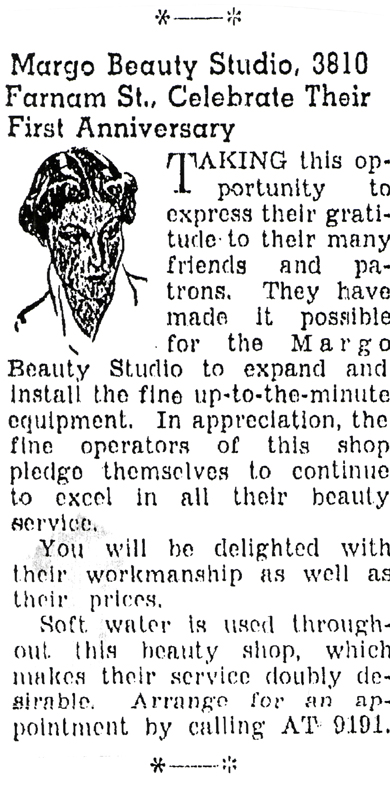
September 27, 1936 All I want to know is, was this the real Margo?
I found indication that by 1937 Margo Beauty Studio added, the apparent, side business, the Spic + Span Cleaners and Tailors to their distinguished small business offerings. Margo Beauty Studio and the Spic + Span Cleaners and Tailors made their evolvement official, although not as lyrical to the tongue. Of note, Otto Bartels, the infamous local baker, shifted part of his operation to 3812 Farnam. All traces point to Bartels Bakery being located at 2401 Harney Street. Otto was the baker and his wife, Mary, evidently worked the store. I suspect 3812 was either an additional storefront bakery or Bartels baked out of the West Farnam location. Either way the couple had their work cut out for them as their residence was at 3620 3rd Avenue in Council Bluffs. He was well known as a “pastry chef” who had previously worked at the Ambassador Café. By 1953 the Bartels were in divorce court. Otto Bartels would go on to marry again in 1958 and was featured frequently in the papers.

Otto Bartels, the fine pastry chef on the left. The article is from January 31, 1932. Previous to Bartels starting his own bakery business, he was pastry chef of Ambassador Café. Here he is shown presenting little Audrey Napier a “sample donut.” Divine. Audrey is most certainly related to the famous Napier shoe family. For more on the Napier family, check out The Case of Napier’s Booterie and the Securities Building.

April 25, 1939 The Mason Furnace Company ad.
The Mason Furnace Company, under manager Thomas S. Hubbard, began conducting business at 3812 Farnam in 1938. I stumbled across numerous ads for “Man to sell over phone” and also “Furnace cleaners—must have own car—see Mr. Geis.” This must not have been an easy position to fill, judging from the frequently run ads. By 1939 the ads insisted, “Single Men—we have an opening. If you have sales ability we offer salary and commission.”
1940s Dossier
 May 11, 1940: Mason Furnace Company ad.
May 11, 1940: Mason Furnace Company ad.
Perhaps because of the demanding over-the-road, door-to-door furnace sales business or the location simply didn’t suit them, the Mason Furnace Company moved on in 1941. The Margo Beauty Studio—Spic+Span Cleaners and Tailors remained at 3810. Reitz Sale and Service Repairs likewise continued on at 3814. By 1945, the Walter C. Roessig & Co. (an awning company) had moved into 3810 Farnam Street. The Walter C. Roessig & Co. was known, besides their canvas awnings, for their “fitted truck covers.” 3812 remained untenanted. The Lloyd Motor Company shifted into 3814 Farnam.
The 1946 Mom and Pops
At this time, 3810 Farnam housed the G.A. Steinheimer Company, contractors. Naturally this company was owned and run by George Steinheimer. I discovered a small article explaining the nature of his enterprise. “George A. Steinheimer contracting, painters, paperhanging, decorating, commercial, industrial and public buildings, retail pain and wallpaper store.” In this same year, the 3812 bay was taken over by the General Housing Company. Donald M. Demont owned General Housing Co. I was perplexed by this vague company name until I found many similar ads, alluding to roofing and siding.

June 13, 1946: roofing, siding-insulation General Housing Co.
I found a piece of evidence by way of a 1946 fire call to the properties. Allegedly, a negligent passerby or a Colonial Hotel patron threw a cigarette on the awning and started a fire. Could this have been one of the infamous Walter C. Roessig & Co.’s awnings? From the mid 19th Century until the 1950s and 1960s, canvas awnings were extremely popular on commercial buildings. It made sense that 3810 and 3812 would have had canvas awnings attached to their large picture windows.

From July 30, 1948 “Three years of heartache and worry.” This article looks and reads like an old time tabloid, which probably why I love it so. The darkness of the black and white photocopy only enhances it. Donald Demont, from the General Housing Company at 3812 Farnam is charged with running off with a former POW and his wife’s money. Dement was allegedly using their money on another project of his, meanwhile a $4,000 lien was put on their house. Charges of obtaining money under false pretenses were filed against, Donald Dement. Also pending were two additional suits resulting from similar deals. In 1948 former General Housing Company operator, Donald Demont was charged with three counts of failure to apply money received against labor and materials. I would guess he closed up shop and that is when 3812 became available once again. In the meantime Hymie Borsky Auto Repair then moved into the neighboring business 3814 Farnam. Love the name.
I traced a collection of uncertain breadcrumbs to 3812 Farnam. By November 4, 1948 there was a small ad for “Grocery and delicatessen merchandise $2,500, terms on fixtures. Julius Newman.” This was puzzling as the General Housing Company had very recently moved out and there was no listing for a grocery at that location in the meantime. More detective style head scratching ensued after reading another mysterious ad from this time period.” Sparkling fixtures, inviting store, desirable Omaha location, clears $12,000, secure lease.” What I surmised about these ads was that Julius Newman was Jules Newman or a relative of the Hinky Dinky Newmans. I assumed they were using 3812 Farnam, in General Housing Co.’s absence, to move some old Hinky Dinky fixtures and dead stock. But the second ad alludes to a grocery delicatessen having very recently closed. After much investigating, what I discovered was that Julius Newman ran a Real Estate empire. Located at 1211 City National Bank Building, Julius Newman had a hand in the buying and selling of what appeared to be all of Omaha. I exaggerate but the evidence is staggering. I enjoyed a weird little write up in the OWH article of September 16, 1949, “When Julius Newman was buried Wednesday, three of the pallbearers were also named Julius Newman and all four were cousins of varying degrees.” If you are paying attention, this, of course, does not solve our little mystery about why Julius Newman (one of the multiple who still lived on in 1949) was selling fixtures out of 3812 Farnam and also renting the space.
In the year 1949, G. A. Steinheimer Co was still doing business out of 3810 Farnam. The Forbes Delicatessen & Bakery, owned by Irving J. and Herbert R. Forbes must have taken Julius Newman up on his offer, making 3812 the site of their new commercial endeavor. 3814 became Weber Tire Company.

July of 1949 aerial view (sideways image) of 38th and Farnam. Hinky Dinky is shown in the lower right. Colonial Hotel, without awnings, and what must have been Steinheimer Co. and Forbes Delicatessen & Bakery. Notice the two-way street and recently severely chopped trees along Farnam. (Photo courtesy of the John Savage Photography Collection at The Durham Museum Photo Archive).
1950s Dossier
In an OWH article from May 24, 1950 I discovered “Farnam Liquor permit granted” to Herbert and Irving Forbes, delicatessen owners at 3812 Farnam. By July 1950 the commission then refused to issue off-sale beer permit “because there are enough liquor licenses in the neighborhood.”

Circa 1950’s black & white of snowy street scene, facing west. (Photo courtesy of the Bostwick-Frohardt/KM3TV Photography Collection at The Durham Museum Photo Archive).
The Steinheimer Company moved out of 3810 in 1951 and presumably later that year Midwest Utility Service Co. Inc. took over the lease. This company sold Midwest Heater Company heaters. I found John G. Cameron listed as president of the small company and Dorothy Cameron (his wife?) listed as vice president. E. F. Heafey was secretary treasurer. E. F. Heafey was a relation to the well-known Heafey and Heafey Funeral Home business. See related link on the Heafey family: Mysteries of Omaha: 3825 South 25th Street.
From numerous OWH articles of 1950, a year before Midwest Utility Service Co. moved to Farnam Street, I found a web of serious detective work by a young reporter, Harold Anderson—the same Harold Anderson later accused of involvement in the Franklin Credit Union Scandal. Anderson uncovered a mysterious (accused of being unethical and illegal) traffic in appliances by the Metropolitan Utilities District (MUD) directors to their friends and colleagues around town. The 53-page report (fascinating!) investigated the involvement of Dr. Willard H. Quigley (MD in private practice), chairman of the MUD board of directors and Cornelius “Con” Heafey (funeral director of Heafey and Heafey), MUD board member. Among many, many names exposed in the report, “John G. Cameron, executive of Midwest Utilities Company, had a Roper range delivered to his home at 2440 Redick Ave. on December 12, 1948.” Cameron told investigators “It was nobody’s business.” Dr. Quigley said “Mr. Cameron had done many favors” and that “Dr. Quigley obtained the range for him.” In another article it appears that Cameron had been receiving the ill-gotten MUD appliances at his Midwest Utility Service Co. 1614 Izard location before they moved to Farnam. That must have been the favors part. Apparently this whole appliance scandal must have blown over or gotten brushed under the rug because by 1951, the Camerons and relation, E. F. Heafey continued to operate as Midwest Utility Service Co.
I had reached out to Kristine Gerber of Restoration Exchange Omaha. She generously shared two photos “taken by the late Bill Kratville, a photographer and streetcar lover who took many pictures in the 1940s, 1950s and 1960s of Omaha’s streetcars.” These 1950’s photos aid in the description of what the Farnam commercial district looked like at the time.

1950s, looking east on Farnam Street. Hinky Dinky seen on the left and the Blackstone Hotel in the distance. Large houses still seen on both sides of the street. A streetcar makes its way east. (Photo courtesy of the William Kratville Photography Collection at Restoration Exchange Omaha Photo Archive).
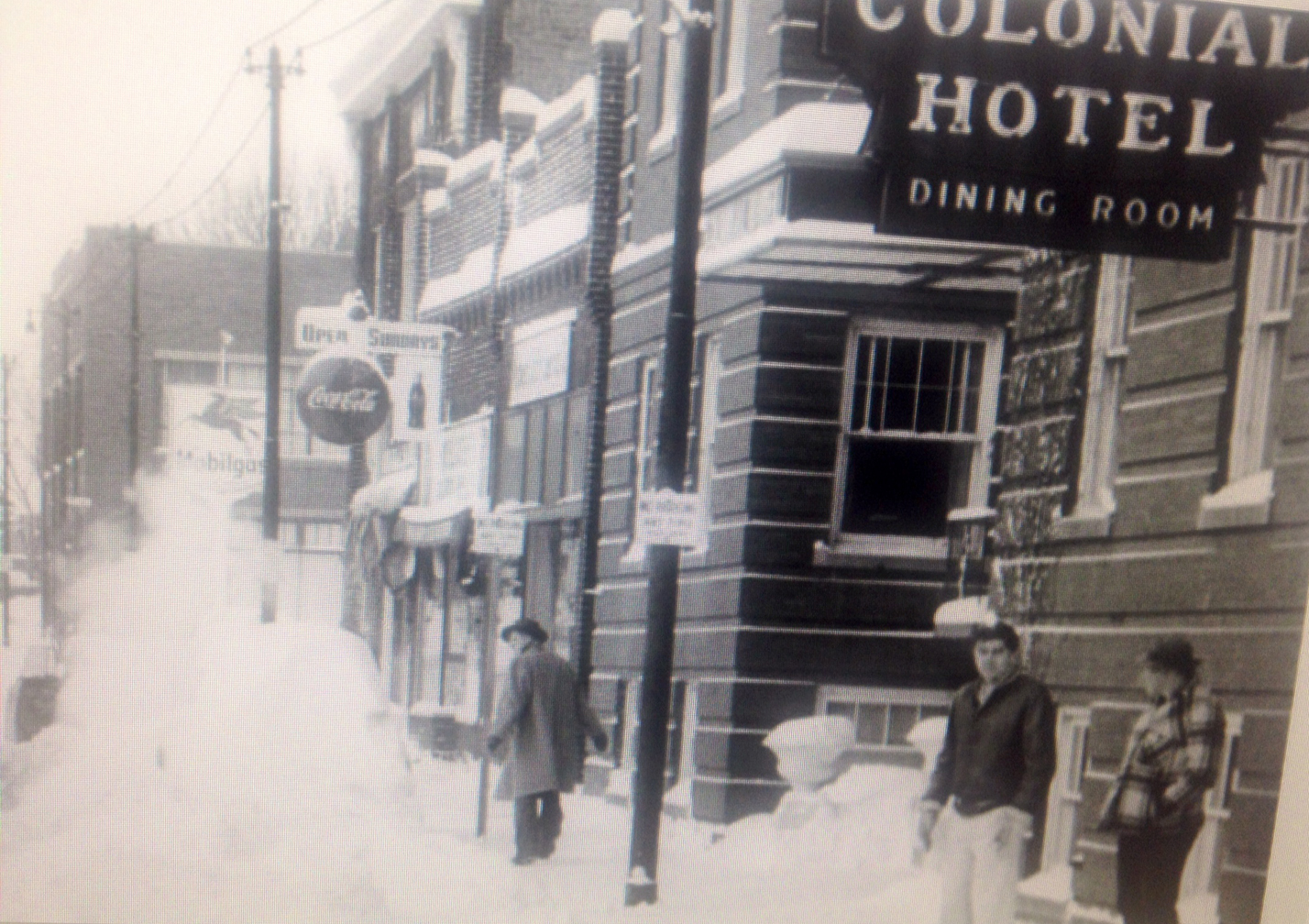
1950s. Detail of Coca cola sign in front of Forbes Delicatessen. Also the Mobile Gas sign down on the corner represents the brand new filling station.
By the year 1953: Hinky Dinky continues a solid business at 3720. 3804 Farnam, Mrs. Helen G. Maurer then ran the Colonial Hotel. The Midwest Utility Service Co. was still leasing 3810 and 3812 is Forbes Delicatessen and Bakery. At 3814 Farnam, Homer O. Mosley and Malcolm M. Segal move in under the business name, Mosley-Seal Manufacturing Co. (furniture). A new kid joins the block at 3824 Farnam and becomes Halbert Fitzsimmons Gas Station. This parcel would function as a gas station until just very recently.
1954 brought another big shift in small businesses. 3810 became the William Pappas Cocktail Lounge. I would have liked to see that place. 3812 Farnam became the Farnam Laundromat owned by William P. and Lois Sharp. The very next year, William Pappas moved out and the Picker X-Ray Corporation of Nebraska moved in. This appeared to be the first national chain to move into the Gold Coast area. I located many Picker X-Ray companies all with state or region names. The Farnam Laundromat became “self-service,” a very big deal, in 1956. The 3814 Farnam building, Moseley & Segal Company also listed its sister company of Nebraska Draperies Inc., for the first time. The Stoll’s Mobil Service Gas Station moved to the neighborhood in 1956 and would remain there until a few months ago. It was recently demolished for the Greenslate Development-Jay Lund project, Blackstone Station. Look into:http://blackstoneomaha.com/blackstone-station/. It is one of Those Developments I have written previously about. Check out New Omaha: Apartments.
 Stoll’s filling station at 3824 Farnam, later became Stoll’s Auto Service and Towing. Now site for the Blackstone Station.
Stoll’s filling station at 3824 Farnam, later became Stoll’s Auto Service and Towing. Now site for the Blackstone Station.
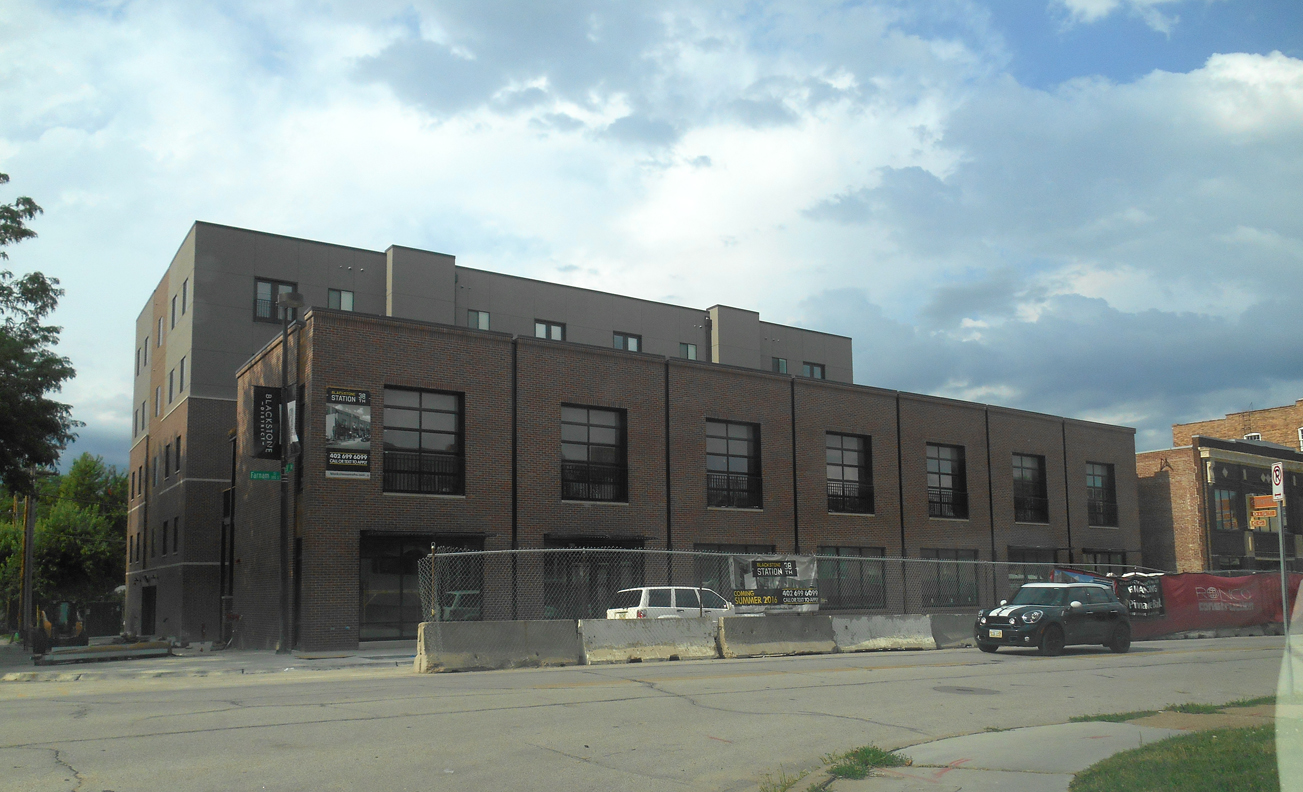
Stoll’s Auto Service as it looks now.

March 15, 1956 Farnam Street Laundromat—found listed amongst Top Value Stamps merchants.
I found an ad for Mosley-Segal Furniture Co.’s going out of business sale from the OWH November 7 of 1956. The ad said “Free Parking at Stoll’s Mobile Service Next Door West.” It is interesting to think that Stoll’s was always used as a parking lot for the sister buildings to its east. After Mosley-Segal went under 3814 becomes Hammond Furniture Company run by owner Fred D. Hammond. The year was 1957.
1960s Document Case

October 18, 1961 aerial view of 38the and Farnam. Visible is the crest of the Red Lion Lounge and the side entrance. (Photo courtesy of the Bostwick-Frohardt/KM3TV Photography Collection at The Durham Museum Photo Archive).
Our little Mom and Pop Block began to get a wee bit more colorful in the 1960s, reflected in all areas of American life. It was 1962 that the Colonial Hotel first listed their Red Lion Cocktail Lounge. This very cool lounge featured a basement entrance on the east 38th Street side of the building. There was a striking lit sign hung on the corner of the Colonial in the shape of a crest with a lion in profile. The Red Lion was known for embracing the new jazz movement and local legend, Joe Voda is rumored to have played his first gig there. Soon after opening Sunday nights became“Little Theatre” nights at the Red Lion, where the small lounge was turned over to the Repertory Players, a small company of touring actors. During this year Picker X-Ray packed up and moved out of 3810 Farnam. In 1963 Stone Servicemaster Inc. Carpet Cleaners inhabited 3810, Farnam Laundromat continued business as usual at 3812 and the Frank L. Young Company, manufacturing agents took over 3814 Farnam.

Addendum: This just in from Father of Miss Cassette! Father of Miss Cassette offered up this great original ad from his favorite old haunt, the Red Lion. You can see the crest even better. “Farnam at 38th OMAHA, NEBRASKA. ‘Just 15 miles off the strip.'” Perfection.
Part Two
The Brothers Firmature Cocktail Lounge
In some ways the dawn of the story I thought I knew. I was absolutely thrilled to find a piece of evidence from the early beginnings of my favorite Mom and Pop of all. In May 17, 1966 a building permit was run in the OWH for “remodel cocktail lounge $5,000” at 3812 Farnam Street. After this lead, the clues just came rolling it.
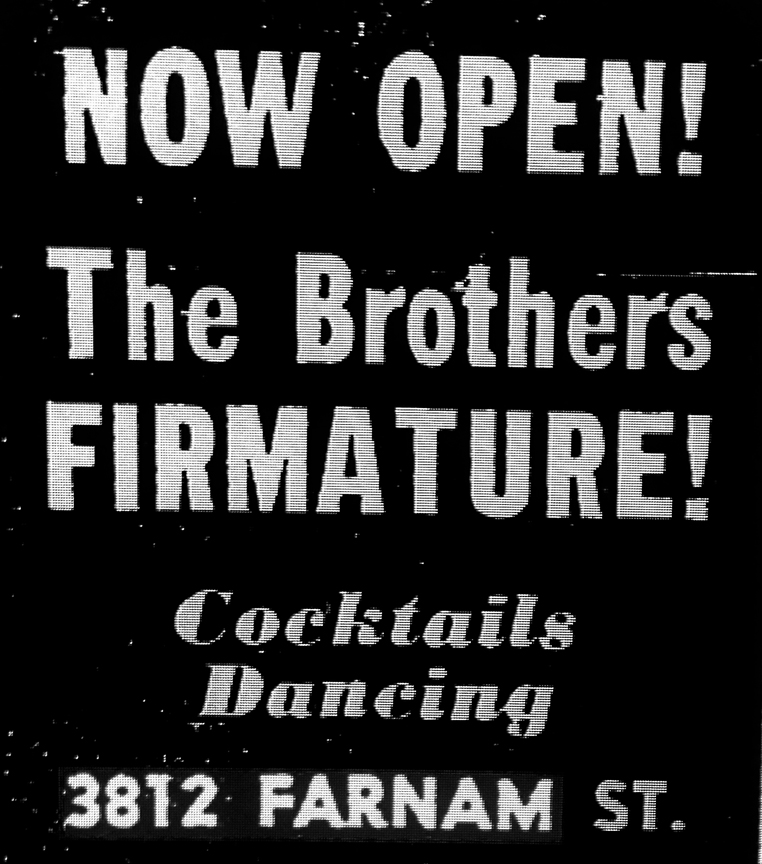
From the OWH June 7, 1966 NOW open!! Brothers Firmature

My favorite, absolute favorite was this article from June 10, 1966. A small dance floor and a jukebox with no rock ‘n’ roll records. The bar was decorated by the same designer who imagined the Gas Lamp.
By 1967 3810 Stone’s Servicemaster Inc. endured neighboring 3812 The Brothers Cocktail Lounge. I had always heard from Mother of Miss Cassette that her and Father of Miss Cassette, in their early dating years, used to frequent the Brothers Lounge with friends. They would then swing by the Red Lion at the Colonial Hotel for some live jazz. If they were really painting the town red, they’d dip back down to the Players at 3259 Farnam. Richard Duda and Eugene Corcoran ran the Players and I guess this was quite the spot. Upon further research I found that along with the Players, Red Lion and Brothers, Farnam Street had many nightlife offerings in 1967: The Embassy Club Tavern, Sullivan’s Bar, Whitey’s Package Liquor and Purcello’s Cocktail Lounge, to name a few in the Gold Coast area.

The Brothers Firmature in 1966. (Photo courtesy of Trey and Lallaya Lalley.)
Firmature Family news
The famous Omaha Firmature brothers founded the Brothers Cocktail Lounge in 1966. Although I had long heard the name Firmature in Omaha lore, I did not truly know all that much about them. According to the Omaha census of 1940, Joseph and Barbara Firmature had three sons Ernest, Joseph, Jr., and Robert (known later as Ernie, Jay, and Bobby.)
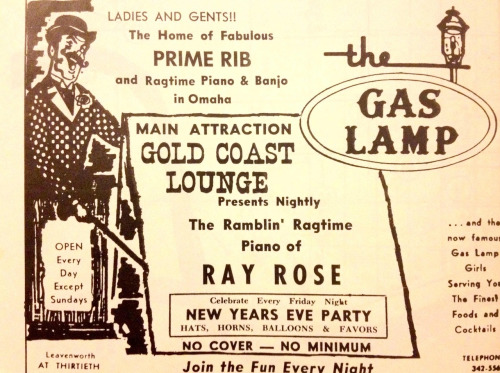
**Update from November 2, 2021**
Relative Jon Firmature wrote in to clear up a mistake of mine. Joseph and Barbara Firmature, the brothers’ parents, were not credited with having started Trentino’s; Trentino’s on 10th and Pacific was actually started by Joseph’s brother and sister in law, Sam and Helen Firmature. Trentino’s was one of Omaha’s original Italian steakhouses and would later become Angie’s Steakhouse (now the site of the new Bluebarn Theatre.) The boys learned the business by working along side their parents in the Italian tradition. The brothers would go on to create, own and operate a number of Omaha’s favorite establishments such as the cocktail lounge in Angie’s Steakhouse, Firmature’s Restaurant at 7775 Cass St; Gas Lamp (30th & Leavenworth); The Brothers; Cheyenne Social Club; the Tickertape, long time favorite lunch spot on 17th and Douglas; and Firmatures’ Sidewalk Café at Regency. Ernie Firmature also ran the Mt. Fuji at 72nd & Blondo. Later cousin Jim joined the ranks as well as sons, Tom and Steve. Check out this OWH article for more details on this incredible family.
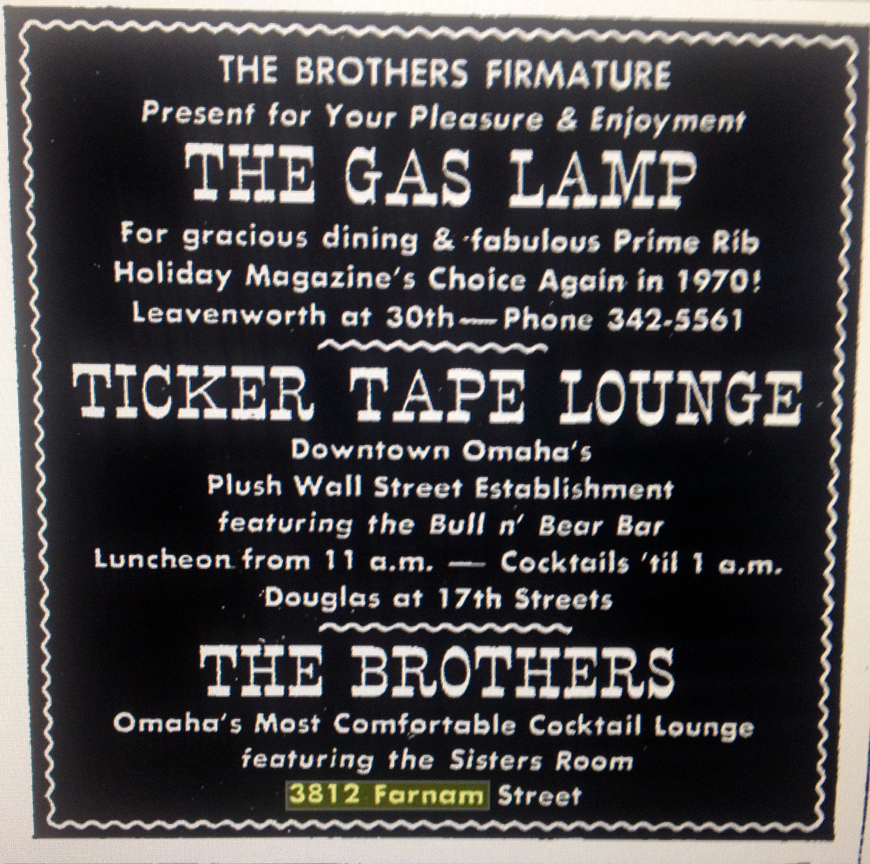
Gas Lamp, Ticker Tape Lounge and the Brothers presented for your pleasure.

The original handpainted sign still hangs at the Brothers.
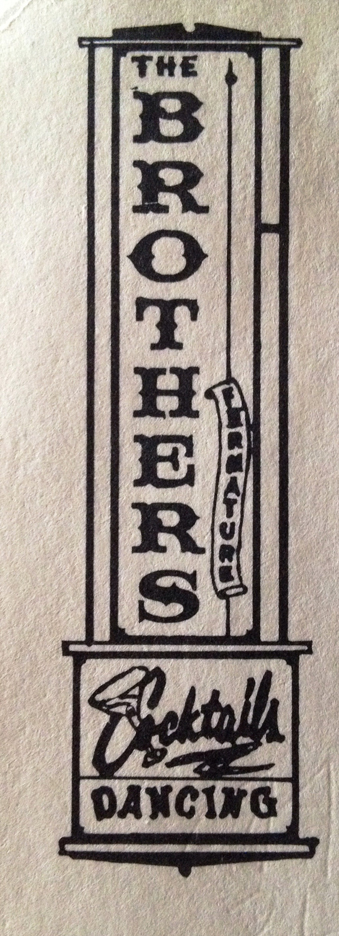
Original illustration of their sign.
1970s Dossier

Ad from April 18, 1970 must be able to wear costume. Other ads said 22 to 30 years of age. At this time the waitresses wore black leotards with fishnets and heels. They were known to have large bouffants. The male bartenders, of course, wore cumberbunds and bowties.

Brothers credit slip. I can’t imagine a time when a tab was run at a bar. Dangerous. “Just put that on my bill.” Lord. In other matters of paperwork, according to the old Brothers’ applications, there were questions for female applicants about their measurements, height and weight, “Do you have any kids?” “Are you married-divorced?”
I began to wonder at what point the Brothers Lounge took over and expanded into the 3810 bay. It would appear that by 1970 Stone Servicemaster Inc. moved out of 3810. In 1971 the 3810 address fell off the city books and became known wholly as 3812. Another question that I was not able to solve–what was the Sisters Room? Was this the girls’ restroom? Was the expanded 3810 bay known as the Sisters Room? Maybe a reader knows the answer. By the way, Frank L. Young Co. continued doing business out of 3814 Farnam, later adding Arlon Miller Co to the lease.

July 1970 Sister’s Room
I was able to meet and interview a local woman who wishes to remain anonymous. She, along with a group of young friends, was renting the large Farnam tri-plex on the corner at this time. According to her, by the early 1970s the Farnam Street commercial strip in the Gold Coast area was thought of as “run-down.” The Colonial Hotel was thought to be “seedy.” As we have continued to see, Omaha continued to move west. Likewise the Old Market was drawing a lot of hip artists, musicians and youth culture to the downtown area. Many students, artist types, transients and older people lived in the apartments and rooming houses up and down the Farnam street corridor. I imagined a scene from Ghost World comics complete with eccentric wanderers and jazz lovers.

The buffalo head still seen above the fireplace supposedly was an early “neighborhood house warming gift” from the son of Arthur Storz. This buffalo head was said to have hung (maybe in the trophy room?) at the Storz Mansion, 3708 Farnam, up until 1966 when it was gifted to the Brothers Firmature.

The Central Distributing Company, a long time Omaha staple, in business since 1933, set up their new digs at the large 3814 Farnam building in 1974. This company sold coin-operated equipment—games and vending machines. Central Distributing maintained this location until 1994. Their large orange sign remains to this day.
1980s File
During the late 1970s or 1980s the Brothers Lounge added the warm and welcoming shake shingle awnings to the large front windows. The wood shake was also carried through to the sign for added cohesion. The Colonial Hotel, the Brothers Lounge, Central Distributing Company and Stoll’s Mobile Service and Gas Station sustained their small neighboring businesses throughout the 1980s.

This fantastic photo was retrieved from the Blackstone Neighborhood 1987 survey archive. Trina Westman, of Urban Design and Historic Preservation at Omaha Planning shared this with me. I love it. Especially the crustiness, which makes me think it might be a Lyn Meyer photo. (Photo courtesy of the Omaha City Planning Photo Archive).
1990s Clues
The Brothers Lounge continued its homey, neighborhood bar tradition into the 1990s. Its patrons were mostly older, area locals who wanted a quiet place to talk and play pool. On April 7, 1992 the Brothers Lounge became the City of Omaha’s first keno satellite. Other bars and private clubs would follow suit. I found a great article from June of 1992 where Dewey Houghton, owner of the Colonial Hotel and another patron had purchased winning keno tickets from Brothers. One had an “apparent winning ticket of $200,000 and the other a ticket worth $80,000. Bob Firmature, the Brothers manager, said Sunday that glitches in the computer system that connects satellite keno games to the main Big Red Keno parlor have been common.” Houghton spoke of the Keno officials, saying, “Hopefully they’ll decide to pay us.” I have no idea if those big Brothers tickets eventually paid out but I like to think of the Colonial Hotel owner getting his due. In 1994 Central Distributing Company pulled up stakes, leaving Farnam Street for their west Omaha location.
Part Three
Trey and Lallaya Lalley
Trey and Lallaya began going to Brothers Lounge in the 1990s. As Lallaya says, “It was our secret spot.” They wanted a place to hide out, play pool and relax on their one day off from the hectic, socially close-set service industry. You see, the couple was already quite well known amongst the music scene and bar community. They had famously put the Capitol Bar on the music map of Omaha. From 1993 through 1995 Trey’s father, Mick Lalley was involved with the Capitol Bar down on 1514 Capitol. Trey and Lallaya began bringing in the punk and indie bands, both local and national acts, a winning combination along with the old school feel bar and their outgoing personalities. Those shows were some of the best in my life. Their reputation was built on showing older neighborhood folks, any Regular Joe or a touring band equal respect, both with humor, attention to detail and stiff drinks. The two worked side by side, creating a community of loyal patrons. This bar later became Barry O’s Capitol Bar until 1997 when the plat was swallowed up by the $90 million economic development project planned by the City of Omaha and First National Bank.
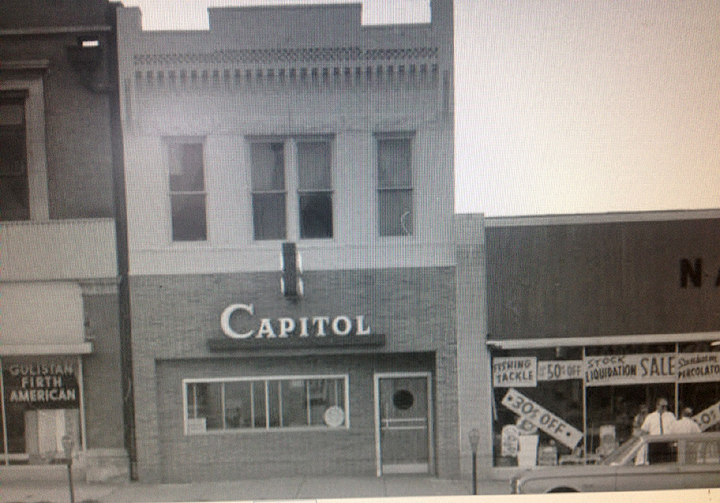
Capitol Bar, 1514 Capitol Street. The 1960s.
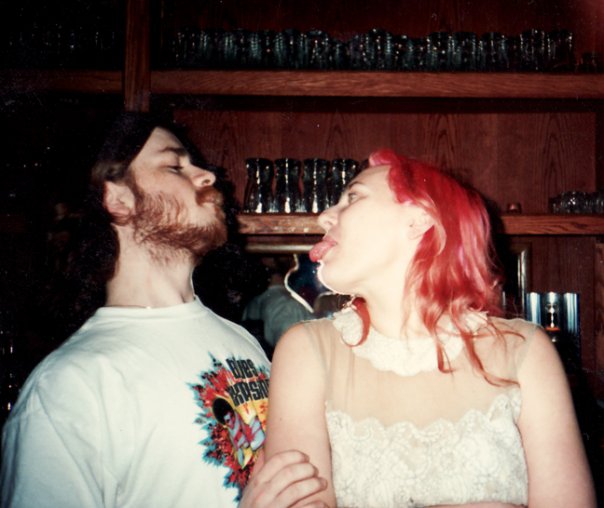
Trey and Lallaya 1994 at the Capitol.
Trey Lalley came from an old school bar family, decades in the service industry. Trey’s grandmother, Ace, owned Theodore’s Bar and Grill on 10th and Jackson Street. I found a fabulous article from February of 1985 where Theodore Parachini, then 73, was remembering when horses were used in the Market area. Apparently his father, Theodore Sr., established Theodore’s Bar and Grill at 601 S. 10th St. in 1918, and Ted Jr. owned the business until he retired in the 1970’s. Years later, Trey’s uncles Tom and Tim bought Theodore’s after their mother, Ace Lalley, passed away. Trey credits his great uncle with having taught him how to bartend. (Bobby Firmature would be a close second and a true mentor.) After the original Theodore’s was razed in 1990 due to the famously ruinous ConAgra’s-Jobbers Canyon situation, Tom Lalley would go on to reopen Theodore’s Bar, adding the Pool Room to the back, on the corner of Saddle Creek and Leavenworth. Trey worked there as well and again brought in a loyal crowd of friends and musicians. In Jan of 1997: Sam Bonofede’s Salvatore’s Restaurant at 4688 Leavenworth St.; Tom Lalley’s Theodore’s Bar and Pool Room at 4684 Leavenworth St.; and Luke Hazuka, owner of Champion Auto Stores at 707 S. Saddle Creek Road, had to sell their properties to make way for a Quik Trip, which remains there to this day.
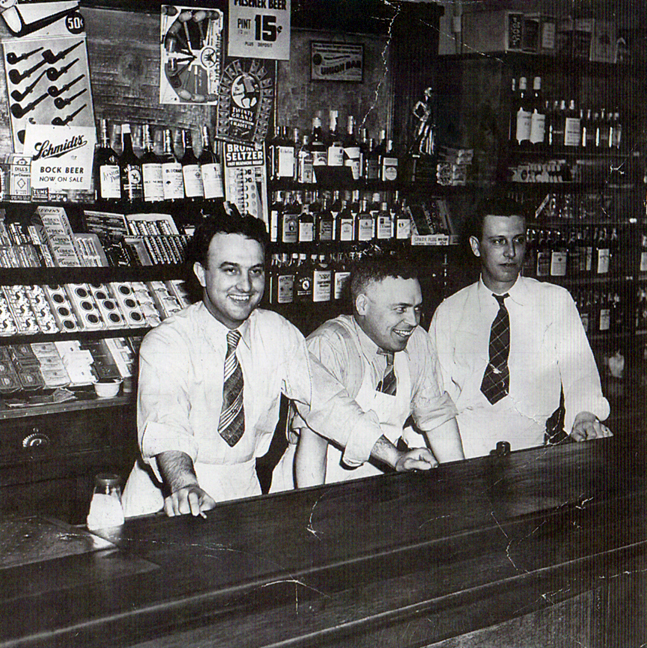
The original Theodore’s Bar and Grill on 10th and Jackson Street. 1943. The best. Just too much for my eyes.
By the closing of the second Theodore’s in 1997, Lallaya was managing McFoster’s Natural Kind Café at 302 S. 38th Street, originally the White Rose Service Station. It was an easy fit for Trey to pick up a shift at their favorite, private getaway, Brothers Lounge, right across the street. The two felt an easy connection with Bobby Firmature. They got close to him over time. It wasn’t too much later that Bobby approached the couple about taking over the family business. The couple agreed to sign a five year contract in January of 1998 to begin to run the lounge. The agreement stated that they would then buy Brothers Lounge for a set price at the end of those five years. This seemed like a good fit for the young couple.
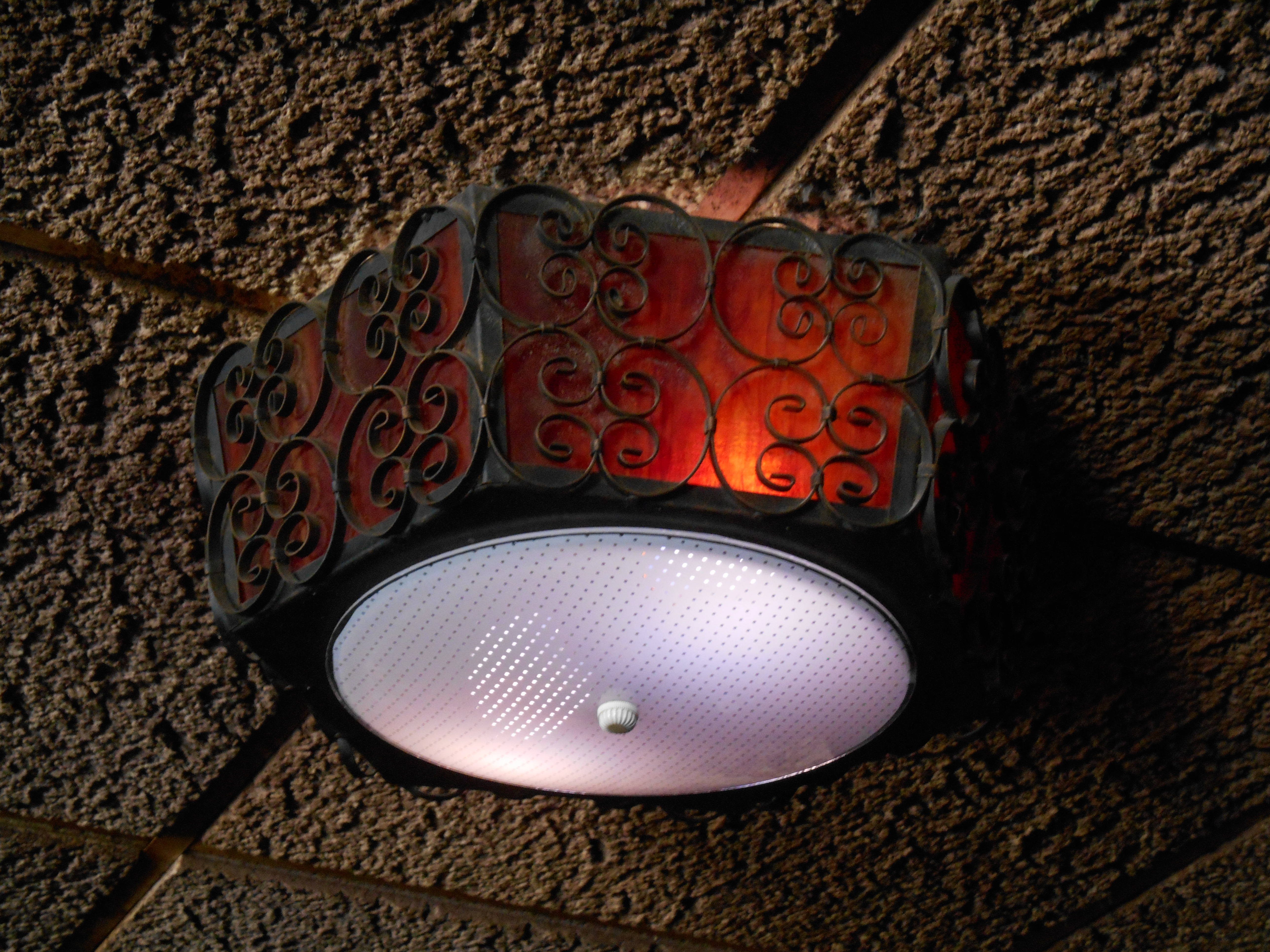
All original lights, still intact.
Trey and Lallaya loved the look and feel of Brothers, (just as we all do,) but they knew there would have to be gradual changes as not to scare off the regulars. For one thing, Lallaya remembered, there were 75-watt light bulbs in every original light fixture, catering to the older clients’ collective loss of vision. It was a very bright place in those days, with older fellas sitting around reading the paper. They would also have to ease in the jukebox, and tailor it to their tastes, something that they are known for. Trey and Lallaya began the work of managing every aspect of the bar, welcoming the established community, getting to know the regulars, gathering the kind of following that only comes from authentic relationships. First and foremost they upheld their own vision of what a bar should be. What a cool bar could be. The loyal friends from the Capitol and Theodore days soon found the couple at Brothers running their own self-styled punk party in what felt like the coolest grandfather’s vintage lounge. Like a big reunion of friends, the Omaha underground music scene had a new home on Farnam Street. And if you were around back then, you knew the Brothers was the original real deal.
 1966 and 2016 photo merge. They have the best door.
1966 and 2016 photo merge. They have the best door.

1966 and 2016 photo merge. Same round globe light fixtures, frame the bar opening into the expanded room.

Detail of Bobby in the front of the bar, showing off the new interior design of 1966. The windows were kept covered for that private, hideaway feel.

2016. Same front area that Bobby was modeling, now with the window uncovered.

2016 Bar interior.
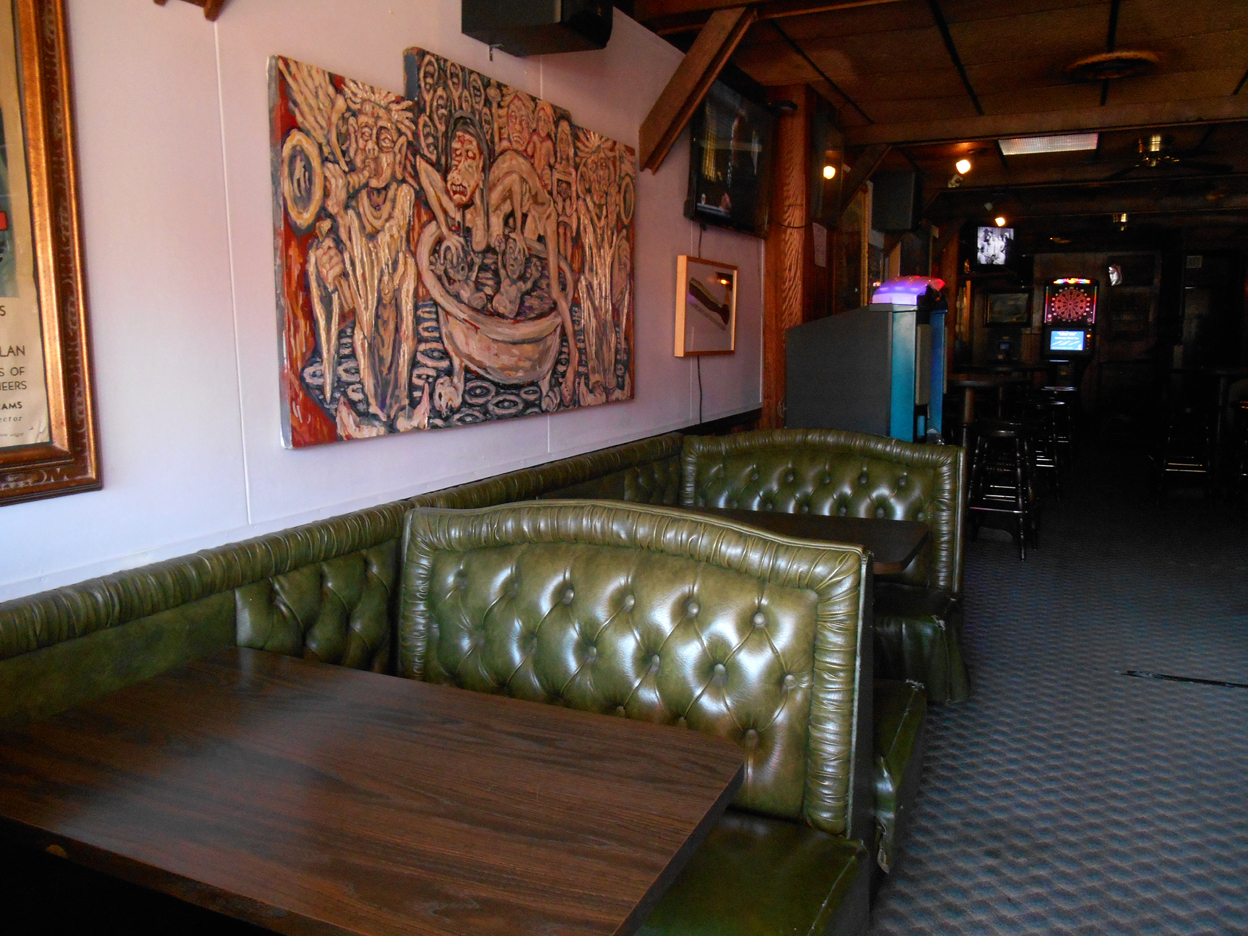
The green booths.

The Other Sister’s Room.

One of the best signs in Omaha…and those yellow light bulbs.
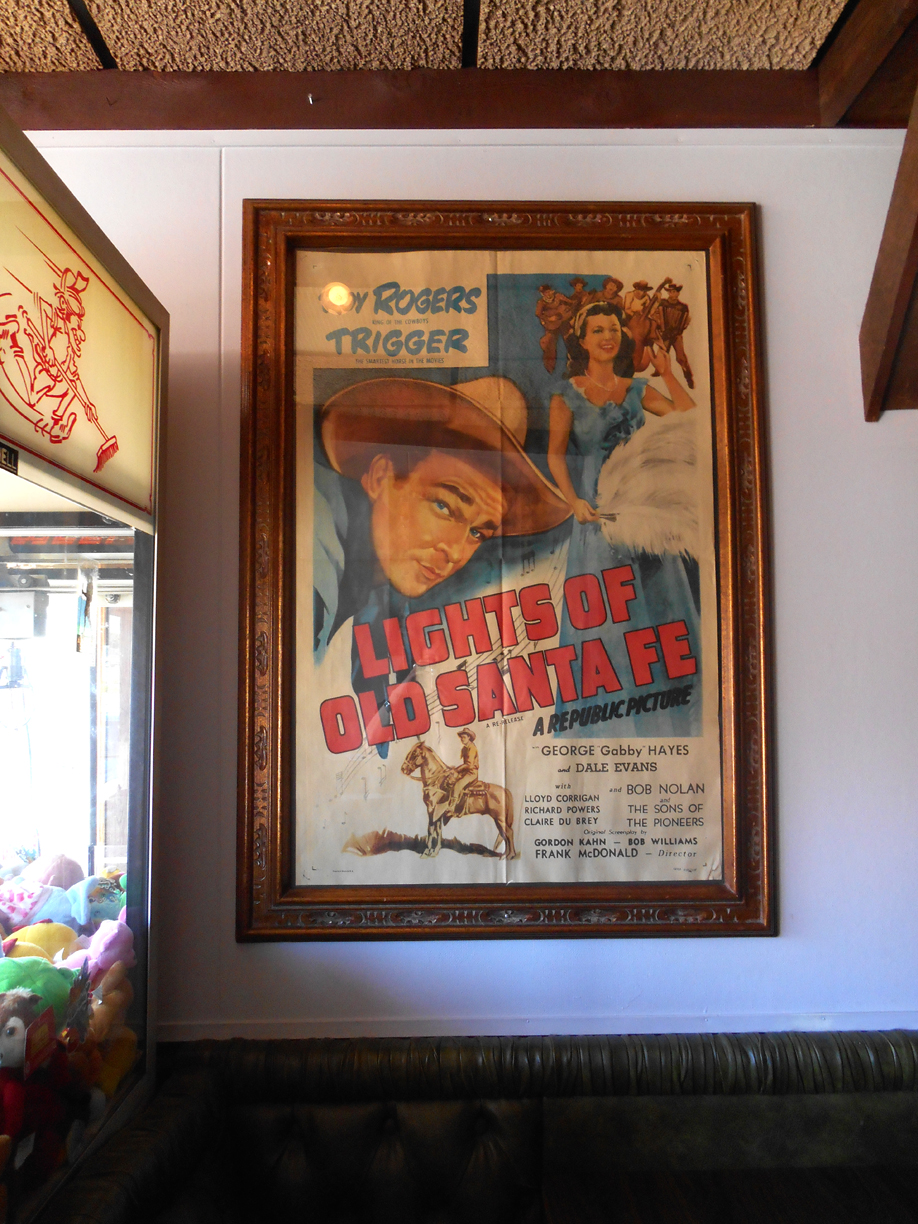
Lights of Old Santa Fe.
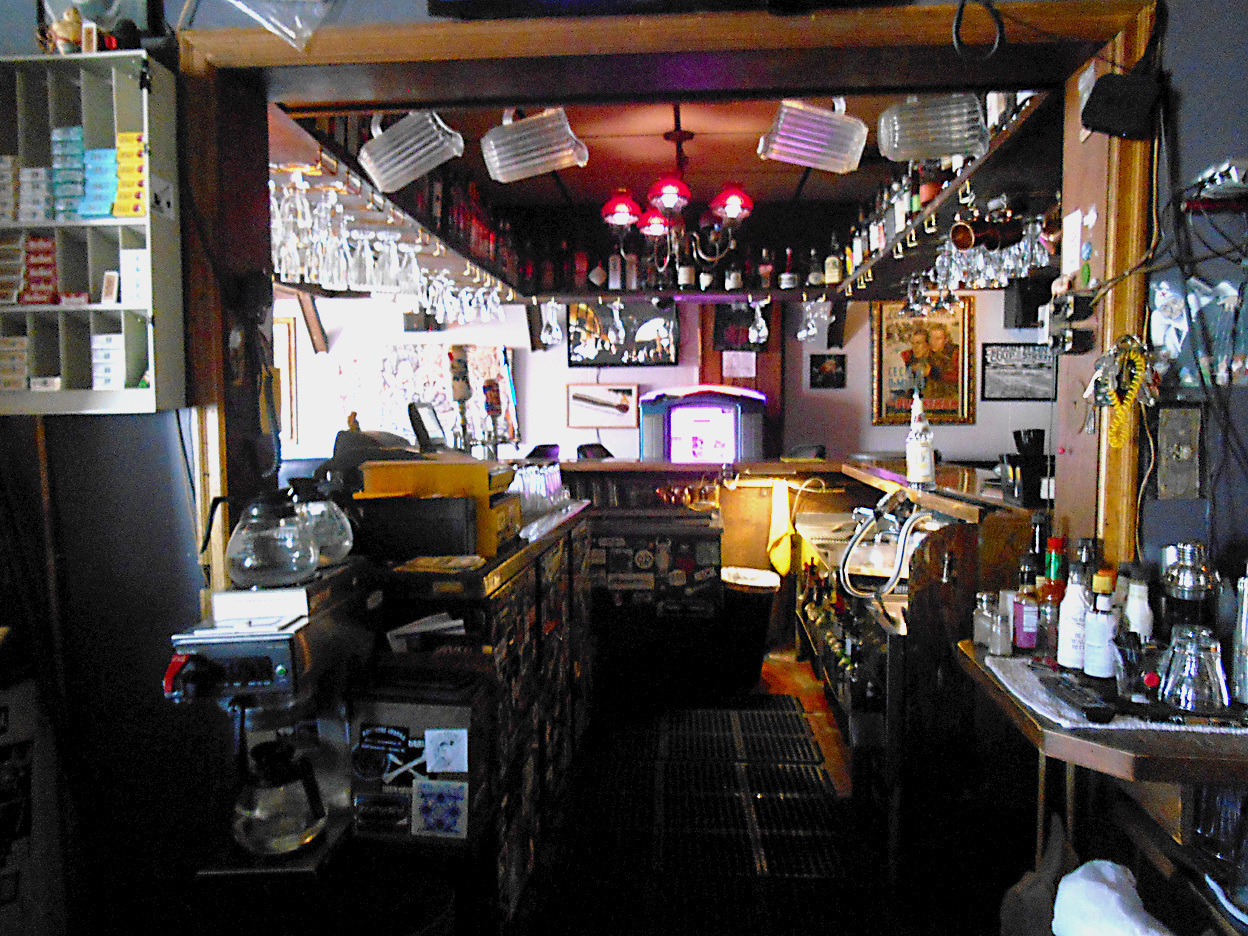 Another original overhead light, view from the expanded room.
Another original overhead light, view from the expanded room.

One of my favorite signs. Why? It’s been that way for as long as I can remember. And Lallaya’s wood-burned hours of operation sign.
2000s Proof
Having known the couple since my high school days, I can say without a doubt that Trey and Lallaya embody the true spirit of the classic, hardworking Mom and Pop, with a little extra sass. In no time flat, Brothers Lounge became the place to be, incorporating their personalities while maintaining the integrity of the original bar. Check out a favorite highlight of mine from 2001. To me, this video captures the Brothers I remember well. https://youtu.be/_Nv2Xzg6lXk. Among numerous praise, Kurt Anderson, Omaha’s favorite son, included Brothers Lounge on his short list of the coolest spots, from the New York Times’ “Omaha’s Culture Club” article of March 25, 2007.

2004 at Brothers Lounge.
In recent times Farnam Street is getting a lot of new attention. A brief perusal of the Douglas Country assessor site shows that most commercial buildings in the area have been scooped up by a few and are being actively reimagined into a sort of midtown Village Pointe. Even the area has been officially renamed, the Blackstone District, a branding that has been stamped everywhere imaginable, lest you forget. A number of the original businesses have been swept along down the road, making way for the new power-washed scheme. Please don’t misunderstand; I want all of these new businesses to make it. I just want a little patina, authenticity, that diversity from the past that set all of the little Mom and Pops apart. Like a breath of fresh air, I can see no better positioning for the real deal Brothers Lounge to influence, inspire and add credibility to this changing neighborhood.
These days an early evening surprise visit to the lounge will find Lallaya mothering all of the locals, to include buying art supplies for a daily patron, getting popcorn ready for an older neighbor who wants to watch his evening news with a cold beverage and purchasing clip-on book lights for the handful of students who use the bar like a library before it fills up. The neighborhood people feel comfortable, corporate types meet after work to discuss the day’s events, the lively kids passing through to play pool feel like they’ve stepped back in time and the underground band setting up for the night’s show load in oblivious to it all. Trey easily banters with the regulars in the steady, professional manner of a man who has, very literally, heard it all. He conversates as he orders for and stocks the bar. Always one to razz particular clients, Trey can also mix a mean drink, a skill he honed as a youngster. Like any good home, you know what you are going to get when you walk in the door. Brothers Lounge was and is amazing to this day. I believe they are one of the oldest, if not the oldest, Omaha bar left standing in its original location. In October 11 of 2012 Trey and Lallaya became the official owners of Brothers Lounge. (And to think that Brothers Lounge has only had two owners in fifty years.) Multiple clubs have tried and failed to create the genuine period feel of this very special space. But most importantly, Miss Cassette is here to tell you, it would be impossible to replicate the real essence of Brothers Lounge, the chemistry and devotion of Trey and Lallaya. Cheers.

© Miss Cassette and myomahaobsession, 2016. Unauthorized use and/or duplication of this material without express and written permission from this site’s author and/or owner is strictly prohibited. Excerpts and links may be used, provided that full and clear credit is given to Miss Cassette and myomahaobsession with appropriate and specific direction to the original content.
I thank you for reading my blog, an intentional, long, slow read. It’s a big commitment on your part, I realize. I welcome your comments about this great area, Brothers Lounge and the incredible people and buildings of the West Farnam, Gold Coast, Blackstone District. I know Trey and Lallaya would love to hear your memories, new and old, of the Brothers as well. To enable comments or to read others’ comments, please click on the header title back at the beginning. If you would like to write to me personally, please do so at myomahaobsession@yahoo.com. Thank you so much for interest in this project and your encouragement. It really means the world.
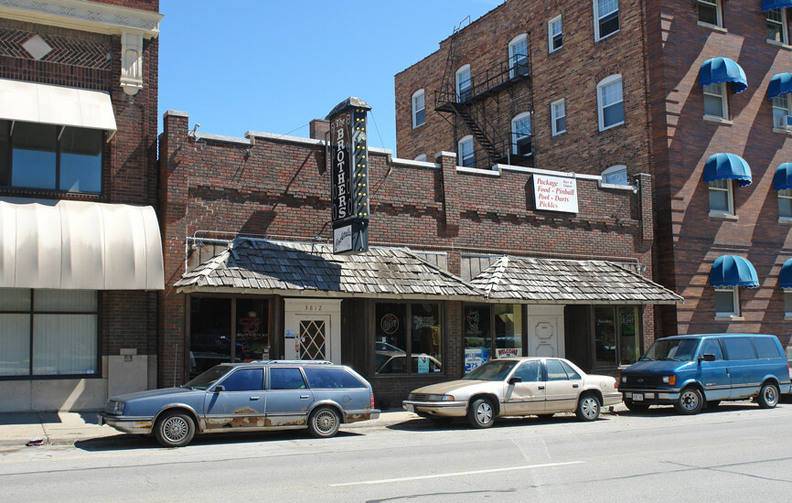
Circa early 2000s. Remember when these kind of cars were the only ones that lined one-way Farnam Street?
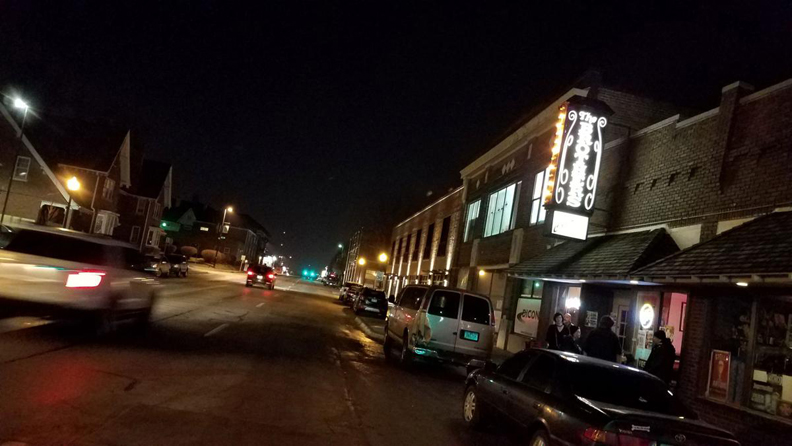
And at last, here is one-way Farnam headed west in 2017. Photo by Gregg Jerrett.

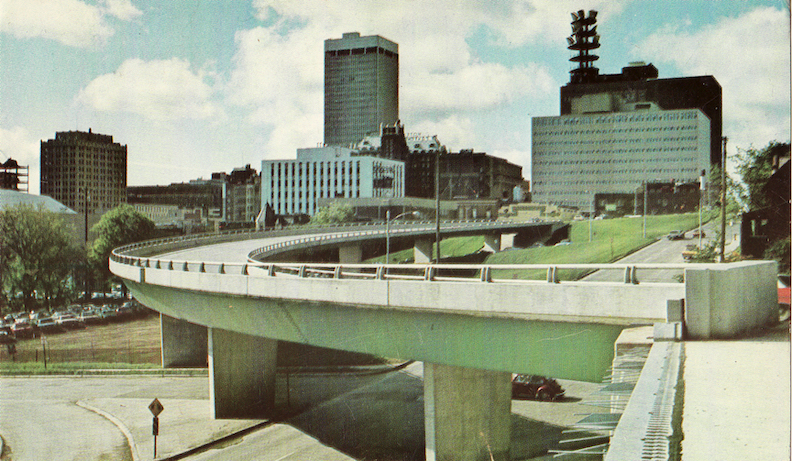

From my experience (late 1970s): The Sisters Room was a mid-size ‘party room’ in the Brothers that could be reserved for parties – popular with groups from Mutual of Omaha for retirement, birthday, promotions, and other celebrations.
Oh Dawn, thank you! Mystery solved. I appreciate it!
The sisters room existed after the bar extended into the 3810 east bay. The Firmature boys told me the cocktail waitresses’ named it cause they wanted chicks to be represented. You are right about that side being rented out for parties. Lallaya
hey Lallaya!
just came across this tonight…..what a cool read, and is making me very homesick right about now! so glad to see you & Trey get the respect you have earned all these years, and i really miss you guys, and those crazy French Connections every damn Christmas too!!
don’t be surprised if you see me stroll in again someday soon…..been way too long i do believe (2005?) Merry Christmas to The Lalleys, and please keep it comin’ until we all drop dead, ha!
XO
Ricky Trux
Wow it has been a long time Rick. The developers have taken over the country including Omaha. Things look weird around some parts. You will need us for familiarity. You know where to find us. Hope all is well…..Lallaya
hey L.L.! thanks for remembering….i will find you guys from those killer jukebox songs, filtering through the stagnant millennial air that is surrounding Brothers Lounge and everything else it seems! god damn, is nothing sacred??
hope you had a great Christmas down there, and will try really try to make it for the next one….Lee said it was still the place to be! hang in there you two!!
XO
Ricky
Way to lay sum knowledge on them Lallaya…Wonderful article… amazing History proud to have been a part of it all the way back to the late 80s…Ricky Olsen.
At about age three 1949, I used to climb what seemed liked very steep front steps at the Colonial Hotel to visit a relative named Aunt Barb
Barbara Stryker related to the law firm HIrd Stryker in the OPPD Building downtown. We also used to eat often at the Old English Inn just
West of 50th and Dodge North side of Dodge in the mid 1950s. This was my parents favorite place to go on Sunday or Saturday night for dinner. I think the
building is still there. Wish there were some pics of the inside.
Great memory! I have some outside shots of the Olde English for a story, but like you, am on the hunt for interiors. Aunt Barb must have enjoyed the area. Thanks for sharing.
What an awesome evolution 3812 Farnam has had! Long Live Brothers!
Can’t thank-you enough Miss Cassette!! We can’t believe all the research that went into this. What a rocky past our little building had & you seemed to find all of it’s amazing secrets. We wish all the Firmature brothers were still around to read this. Jay does get to find out it’s past at least. We will surely hear from him soon. Again all of this is fantastic we had no idea. Our facebook page blew up with so many people loving this. You inspired us, xxoo Trey & Lallaya Lalley
Thank you. That really means a lot. I only wish I could have known the Firmature Brothers! I believe this story has had 34 shares, a testament to the loving community you two have generated.
She nailed it Trey!!!! – or should I use my authentic miss spelling of your name, I was always guilty of (Tray). The picture of you and Lallaya at the Capitol brought tears to my eyes!…. I remember Lallaya’s pinkish red hair like it was yesterday… RICKY.
When I got my first job out of college I worked at 3801 harney. spent a LOT of time at the Brothers. it is my alltime favorite Omaha lounge. Bobby was one GREAT person. L have Great memories of the place. As I think back it was an early day MEAT Market, Espiecially on friday nights.
Now this is the kind of comment I love. If I may ask, what time frame was this? I am wondering if they had expanded into 3810 by then? The reason I ask–I would love to know where the original dance floor was, considering all of the comfy living room furniture and not much space. Maybe in that back area by the darts and restrooms? I’m sure you’ve got a lot of great memories!
The Sisters Room was the walled off area where to pool tables and fireplace are——the wall was removed when they put the keno counter in.
I started going to Brothers in 91 when one of my buddies started bartending there.
The original dance floor was indeed where the dart boards wound up. East side of the building across from the rest rooms. Very small, maybe 10′ X 10′ with a juke box.
Thank you! I bet that made for some intimate dancing or elbow throwing, dependent.
I “discovered” The Brothers in the early 80s when I was a student at UNO. It was the coolest thing I had ever seen: a bar that looked like a living room. When the Blackstone Hotel closed there was a big sale of fixtures, china, etc. I went in with my camera and was able to “explore” the apartments and back-of-house spaces. One of these days I’ll dig up those negatives and scan them. You’re doing a great job and I am really enjoying your very thorough work.
We would all love to see those photos! Keep in touch.
My father, Jerry Rosinsky, and his brothers, Richard and Sol, owned and operated the Red Lion Cocktail Lounge. I believe it operated from 1954 to 1964. My dad took my older brother and me with him on Sunday mornings in the early ’60s. He’d tend to his business while my brother and I listened to 45s on the juke box and messed around on the drums (there was a house band). Dad always concocted unusual and tastey soft drink “cocktails” for us. Good times…
Hello Bob, Thank you so much for writing in. My father and mother both talk about the Red Lion, more so now since I wrote the story. Some day I would like to do a story just focusing on that bar. I hope it will be okay that I keep your email address for the future as you most certainly have many memories. Thanks, Miss Cassette
My family was part of a chapter in Omaha theatre I thought had been forgotten, until I came across your post. I recently learned of the Red Lion’ s reopening, which brought back great memories from my Omaha childhood.
The founders of the Repertory Players were my parents, who’d gotten their starts at the Community Playhouse, and a group of Playhouse friends who became part of the company. They presented plays that hadn’t been done at the Playhouse or elsewhere in Omaha. One of the company’s distinctions was that the group was integrated and cast roles without consideration of race. As a kid, I hung around the club during rehearsals and shows and even did a little acting and backstage work. It was an exciting and magical time and place that ended when my family moved from Omaha in 1964.
Like all theatre people, my parents kept their clippings, which are now in my keeping. A sample is attached. I’ve been wondering if there’s some sort of Omaha theater archive or other place/space that might have interest. Know of anything? Maybe you’re it?
In addition to performing at the Red Lion, they mounted a bigger production, of Playboy of the Western World, at the Blackstone and traveled to colleges and communities throughout the state. For Playboy of the Western World they brought in professional director Adrian Hall, and our family left Omaha in 1964 for Providence when Adrian Hall and my dad were hired to turn Trinity Square into a professional company. Adrian had a decades long career in Providence. My parents went on to have careers at the Guthrie in Minneapolis. Also, troupe member Dick Mueller went on to open the first dinner theatre in Omaha a few years later.
Even being gone over 50 years, I find your blog just great! And I took ballroom dancing lessons from Adelaide Fogg in 1963…
Best,
Mark Schoenbaum
I”m a little late coming to this but saw the repost on facebook. The Brothers was an incredible place thanks to the Firmature Brothers. My daycare was our restaurant Gas Lamp. My dad “Gus’ helped in the kitchen and mom helped with the books but it was Ernie, Jay and Bobbie whose vision all of this was. One thing to add I’m hoping you can update a mistake, they had a good model to follow and that was Sam and Helen Firmature, they owned Trention’s on 10th and Pacific. I referred to my cousind Carmen Davenport on getting that history. Thanks for all your hard work and it’s great to see people are still reposting this story 5 years after it was first posted.
Hello and so good to hear from you! I will go in and make that correction tonight. I really appreciate it! I loved to hear about your daycare. What a family. I thank your family for the incredible contributions to Omaha. Sorely missed.
Thanks for the detective work, and sorry to hear that Brothers is closing.
I hope you’re able to visit one more time to document the interior.
Omaha never got the Top 40 arena shows, but with Brothers, the Ranch Bowl, Peony Park ballroom, and the Music Hall, there was a vibrant market for smaller acts. (It probably didn’t hurt that Omaha was midway from other venues, and tours followed the remnants of the big band and jazz circuits of the early 1900s.)
Reading your parents’ recollections, I remember my parents mentioning nights dancing at the Twin Towers further east on Farnam. Was there a string of night spots on Farnam, or was this separate?
Gonna have to stop in at the Green Onion Lounge on 114th, which was ancient when I was in high school!
(Dunno if there is much interest in Late Modern strip malls…)
As for the NY Times article, you can access their website free at any Omaha Public Library branch, which includes their archives!
https://www.nytimes.com/2007/03/25/travel/tmagazine/03talk.omaha.t.html
https://www.nytimes.com/2018/10/03/travel/frugal-omaha.html
I believe the Green Onion and the Chicago were where the beautiful secretaries drank. That’s what they say. Haha. Report back!